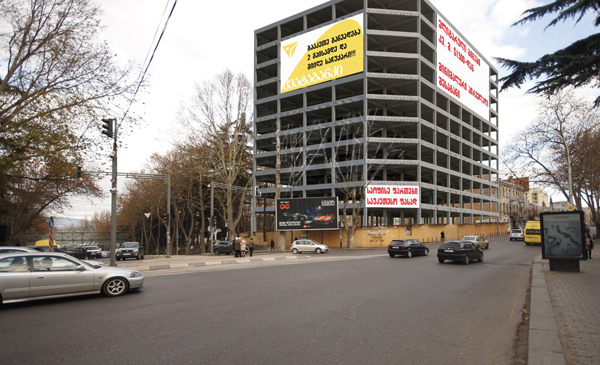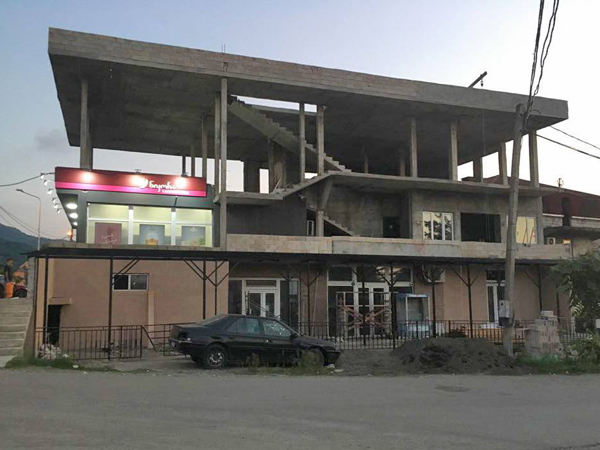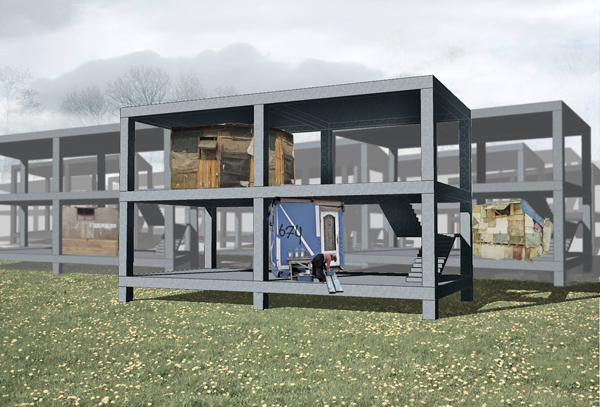"Black Bare Frame - operation Dom-Ino" is an ongoing research project of the studio. Concrete bare frame outgrows the category of structural system and acts as an architectural device for building and city production. From another viewpoint, the bare frame can accept any mask (facade, skin, shell) or Veil thus creating the potential for creative and artistic interpretations.

1915 Le Corbusier presents his "Dom-Ino House" project. At first sight the image presents a mere concrete bare frame as an illustration of the innovative structural system of the time. This is the system Le Corbusier would continue to use in his buildings the following decades. But the architect was right. Dom-ino is more than a mere structural system. It is a space given in its most basic form. Bare frame system is the starting point of industrial mass construction. Soon it became clear that one can easily produce Dom-Ino bare frame using basic primitive means of production. Dom-Ino is thus transformed into Bare Black Frame. Bare frame is the basic architectural technology. (Georgian developers and real estate agents refer to an apartment lacking any amenities ready to be customized by the buyer, as a shavi - black karkasi. In contrast white or tetri karkasi signifies an apartment where the wall and ceiling is plastered, electricity circuits are prepared, doors and windows installed and the floor finished).

The original bare frame, the Dom-Ino is a two-story structure. The real achievement of the bare frame lies in its instrumental role in surplus production of usable floor area (parti - in Georgian). Here we witness the birth of the alliance between multistory highrise apartment building (korpusi) and the bare frame. The unfinished korpusi in its basic form as a bare frame is already a product. Black Bare Frame unfolds in economic, urban, architectural and symbolic dimensions. Black bare frame creates a special vernacular object: parti (name for usable floor area) To buy and sell parti, to expand parti, to "put parti in bank" - these are major urban and economic activities of contemporary urban culture. The parti equipped with its semiotic technologies - the signboards - is constantly communicating to the city advertisement messages.

Signboards are the language of the black bare frame. The defining part of its symbolic dimension. The signboards frame our understanding of the black bare frame as a commodity.

Black bare frame's semiotics involves (besides signboards) other images. 1. Bare frame; 2. Potential parti (text message); 3. commodified parti (image message). Bare fame is the material support of these two semiotic phenomena. This semiotic consumes all semantics of a home. The home is split and fragmented into these two semiotic systems (text and image). On one hand, the Bare Frame produces linguistic messages, informing the consumer on economic opportunities; i.e. the home is transformed into a pure floor area amount. On the other hand, the bare frame gives rise to a new genre of architectural renderings. Here the home is degraded into an axonometric image of a topless box. It is presented as a product to be consumed visually.
Shavi Karkasi, the bare frame serves as the main engine of the whole economic system. Each new parti produced by means of bare frame involves the absorption of all the commodities and services necessary for an apartment in a bare frame: renovation, materials, furniture, workers, fridges, TVs, washing machines and so on. Every single sector of the economic machine comes to motion when engaged with the black frame production (construction and development business).

As an architectural dimension, the bare frame is a shift in the paradigm. In all previous centuries, the buildings were created through cultural traditions of crafting and building. Today the crafting is reduced to pouring of concrete bare fame and fitting it with finishes (all kinds of finish panels and facade systems). Finishism is the architectural manifestation of the bare frame. (For example here is a recipe to make a wooden house: we start by pouring concrete bare fame; onto the set concrete frame we attach PVC panels decorated by wood pattern.)

The bare frame practice shows that the "finishes" and panels are a possible route of development but not the only one. The bare frame is in itself a complete architectural object. The photo on the left shows spontaneous scenarios that arise when the bare frame is called upon even during the ongoing construction phase.

Studio Poetics of Architecture produces the localized version of Corbusier's Dom-Ino. This model (by Nino Gardava, 2018) is the starting object for future interventions. It has all the potential to give rise to new images and ideas.

The coupling of the bare fame with Veils brings to mind new paradigms, where rigid walls are superseded by soft woven surfaces. (3D printed veil model by Nino Mikeladze, 2019; plaster bare frame model by Nino Gardava, 2018).

"Clean and level floor and ceiling. The rest is up to you" Be it Le Corbusier's Dom-Ino or Alejandro Aravena's half-complete social housing units when translated into Shavi Karkasi (Georgian Black bare frame) generate new narratives. Who is the dweller of the bare frame? Read the story here

Each of us has his/her own bare frame to bear.